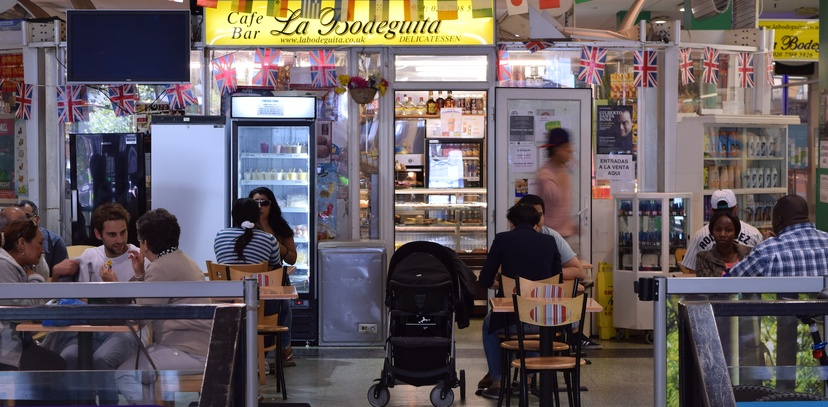
The regeneration of Elephant & Castle is one of the largest and most controversial redevelopment programmes underway in London. It involves the demolition of the Heygate Estate, the redevelopment of the Elephant & Castle Shopping Centre and the creation of new housing, shopping and commercial spaces. There is fierce local opposition to the gentrification of Elephant & Castle, in particular, anger and anxiety at the loss of affordable housing. Southwark Council and the developer Lend Lease have recieved much criticism for their approach, which has seen the displacement of many former residents of the Heygate Estate.
As part of the upcoming Unusual Suspects festival, Social Life have conducted an independent research project in order to understand how the proposed regeneration of Elephant & Castle Shopping Centre will impact on independent traders; their customers, businesses, livelihoods, friendships and local relationships.
Over the summer Social Life spoke to the traders inside the Shopping Centre and in the market and asked them about their history in the Shopping Centre, its importance in their lives, and what they thought about the proposed redevelopment. The outcomes of the research will be presented on the 4th of September at the Elephant & Castle’s Coronet Theatre in Social Life’s ‘Trading Places’ exhibition and online at tradingplaces-elephant.tumblr.com for those unable to make it on the day.
The value of the design and the aesthetics of the Shopping Centre are generally considered low. However, Elephant and Castle Shopping Centre supports, economically and socially, not only individual traders and their families but a number of local communities. It has particular value to the entrepreneurial Latin American Community in Lambeth and Southwark, in providing shops and services, and support and a sense of identity. This value is clear to the people who trade from and use the Centre, but effectively invisible to those who have decision making power over the centre’s future.
“People from different backgrounds sit together. Lots of older people use thIs place as a center for the community”
Elephant and Castle is similar to many inner city areas in London with highly diverse communities, where residents have found ways of securing income, social support, and community identity through trading. These areas – Rye Lane in Peckham, Ridley Road market in Hackney, Stratford shopping centre – are thriving and energetic and are starkly different to the anonymity and homogeneity of the majority of London’s high streets and new shopping malls. We need to find a way of boosting the social and economic viability of areas like Elephant and Castle in a way that strengthens rather than undermines local communities and local trade.
“slowly these kind of places will disappear”
The first step is to make visible the value of current activities, by evidencing this – understanding the social and economic contribution to low income communities - then by setting up dialogues between decision makers, particularly those in local councils, and traders. Councils should display a willingness to enter into dialogue with independent retailers to jointly plan improvements to shopping areas, recognising the value that they can bring to local areas. This should be reflected in local plans and economic development strategies.
Equally, traders need to work together to form networks that go beyond individual interests and focus on common issues. In this way information, solutions and practical action can be shared and traders voice’s can be strengthened.
In London and other cities where commercial rents, house prices and land costs are high, any improvement in local areas will lead to increases in commercial rents and housing costs which can be beyond the means of low income residents and traders unless specific measures are put in place to protect local economic and social wellbeing.
There is a need for developers and shopping center managers to pilot new models that allow space for independent traders to continue to stay in business in the neighbourhoods in which they have created their businesses. This could be done through providing low cost commercial space for local businesses, or by providing tailored support to enable very local businesses to grow. This has to become a specific aim of regeneration strategies from the outset.
Social Life’s Trading Places exhibition and walk-shop, on how to engage local communities throughout redevelopment and regeneration projects, are taking place on the 4th of September. The walk-shop is part of the Unusual Suspects Festival, organised by the Social Innovation Exchange, which features a collection of interlinked events that will draw out the ways in which collaboration and social innovation can work in sync.
We have invited Jerry Flynn, of the elephant amenity network, to discuss the story of Southwark’s Heygate estate and how developers and councils alike can better engage or collaborate with residents, local interest groups and so on in order to achieve more equitable estate regeneration schemes. Patria Roman, of Latin Elephant, to discuss the Latin American communities’ contribution in the area and their advocacy for cultural recognition through a Latin Quarter. And finally, Ed Wall, of Greenwich University, who will be talking about the Elephant and Castle shopping centre and public space.
Sign up for Social Life’s walk-shop here.